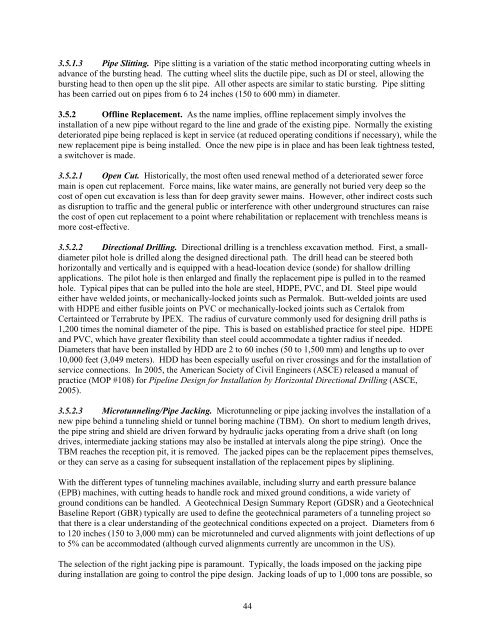State of Technology Report for Force Main Rehabilitation, Final ...
State of Technology Report for Force Main Rehabilitation, Final ...
State of Technology Report for Force Main Rehabilitation, Final ...
You also want an ePaper? Increase the reach of your titles
YUMPU automatically turns print PDFs into web optimized ePapers that Google loves.
3.5.1.3 Pipe Slitting. Pipe slitting is a variation <strong>of</strong> the static method incorporating cutting wheels in<br />
advance <strong>of</strong> the bursting head. The cutting wheel slits the ductile pipe, such as DI or steel, allowing the<br />
bursting head to then open up the slit pipe. All other aspects are similar to static bursting. Pipe slitting<br />
has been carried out on pipes from 6 to 24 inches (150 to 600 mm) in diameter.<br />
3.5.2 Offline Replacement. As the name implies, <strong>of</strong>fline replacement simply involves the<br />
installation <strong>of</strong> a new pipe without regard to the line and grade <strong>of</strong> the existing pipe. Normally the existing<br />
deteriorated pipe being replaced is kept in service (at reduced operating conditions if necessary), while the<br />
new replacement pipe is being installed. Once the new pipe is in place and has been leak tightness tested,<br />
a switchover is made.<br />
3.5.2.1 Open Cut. Historically, the most <strong>of</strong>ten used renewal method <strong>of</strong> a deteriorated sewer <strong>for</strong>ce<br />
main is open cut replacement. <strong>Force</strong> mains, like water mains, are generally not buried very deep so the<br />
cost <strong>of</strong> open cut excavation is less than <strong>for</strong> deep gravity sewer mains. However, other indirect costs such<br />
as disruption to traffic and the general public or interference with other underground structures can raise<br />
the cost <strong>of</strong> open cut replacement to a point where rehabilitation or replacement with trenchless means is<br />
more cost-effective.<br />
3.5.2.2 Directional Drilling. Directional drilling is a trenchless excavation method. First, a smalldiameter<br />
pilot hole is drilled along the designed directional path. The drill head can be steered both<br />
horizontally and vertically and is equipped with a head-location device (sonde) <strong>for</strong> shallow drilling<br />
applications. The pilot hole is then enlarged and finally the replacement pipe is pulled in to the reamed<br />
hole. Typical pipes that can be pulled into the hole are steel, HDPE, PVC, and DI. Steel pipe would<br />
either have welded joints, or mechanically-locked joints such as Permalok. Butt-welded joints are used<br />
with HDPE and either fusible joints on PVC or mechanically-locked joints such as Certalok from<br />
Certainteed or Terrabrute by IPEX. The radius <strong>of</strong> curvature commonly used <strong>for</strong> designing drill paths is<br />
1,200 times the nominal diameter <strong>of</strong> the pipe. This is based on established practice <strong>for</strong> steel pipe. HDPE<br />
and PVC, which have greater flexibility than steel could accommodate a tighter radius if needed.<br />
Diameters that have been installed by HDD are 2 to 60 inches (50 to 1,500 mm) and lengths up to over<br />
10,000 feet (3,049 meters). HDD has been especially useful on river crossings and <strong>for</strong> the installation <strong>of</strong><br />
service connections. In 2005, the American Society <strong>of</strong> Civil Engineers (ASCE) released a manual <strong>of</strong><br />
practice (MOP #108) <strong>for</strong> Pipeline Design <strong>for</strong> Installation by Horizontal Directional Drilling (ASCE,<br />
2005).<br />
3.5.2.3 Microtunneling/Pipe Jacking. Microtunneling or pipe jacking involves the installation <strong>of</strong> a<br />
new pipe behind a tunneling shield or tunnel boring machine (TBM). On short to medium length drives,<br />
the pipe string and shield are driven <strong>for</strong>ward by hydraulic jacks operating from a drive shaft (on long<br />
drives, intermediate jacking stations may also be installed at intervals along the pipe string). Once the<br />
TBM reaches the reception pit, it is removed. The jacked pipes can be the replacement pipes themselves,<br />
or they can serve as a casing <strong>for</strong> subsequent installation <strong>of</strong> the replacement pipes by sliplining.<br />
With the different types <strong>of</strong> tunneling machines available, including slurry and earth pressure balance<br />
(EPB) machines, with cutting heads to handle rock and mixed ground conditions, a wide variety <strong>of</strong><br />
ground conditions can be handled. A Geotechnical Design Summary <strong>Report</strong> (GDSR) and a Geotechnical<br />
Baseline <strong>Report</strong> (GBR) typically are used to define the geotechnical parameters <strong>of</strong> a tunneling project so<br />
that there is a clear understanding <strong>of</strong> the geotechnical conditions expected on a project. Diameters from 6<br />
to 120 inches (150 to 3,000 mm) can be microtunneled and curved alignments with joint deflections <strong>of</strong> up<br />
to 5% can be accommodated (although curved alignments currently are uncommon in the US).<br />
The selection <strong>of</strong> the right jacking pipe is paramount. Typically, the loads imposed on the jacking pipe<br />
during installation are going to control the pipe design. Jacking loads <strong>of</strong> up to 1,000 tons are possible, so<br />
44















